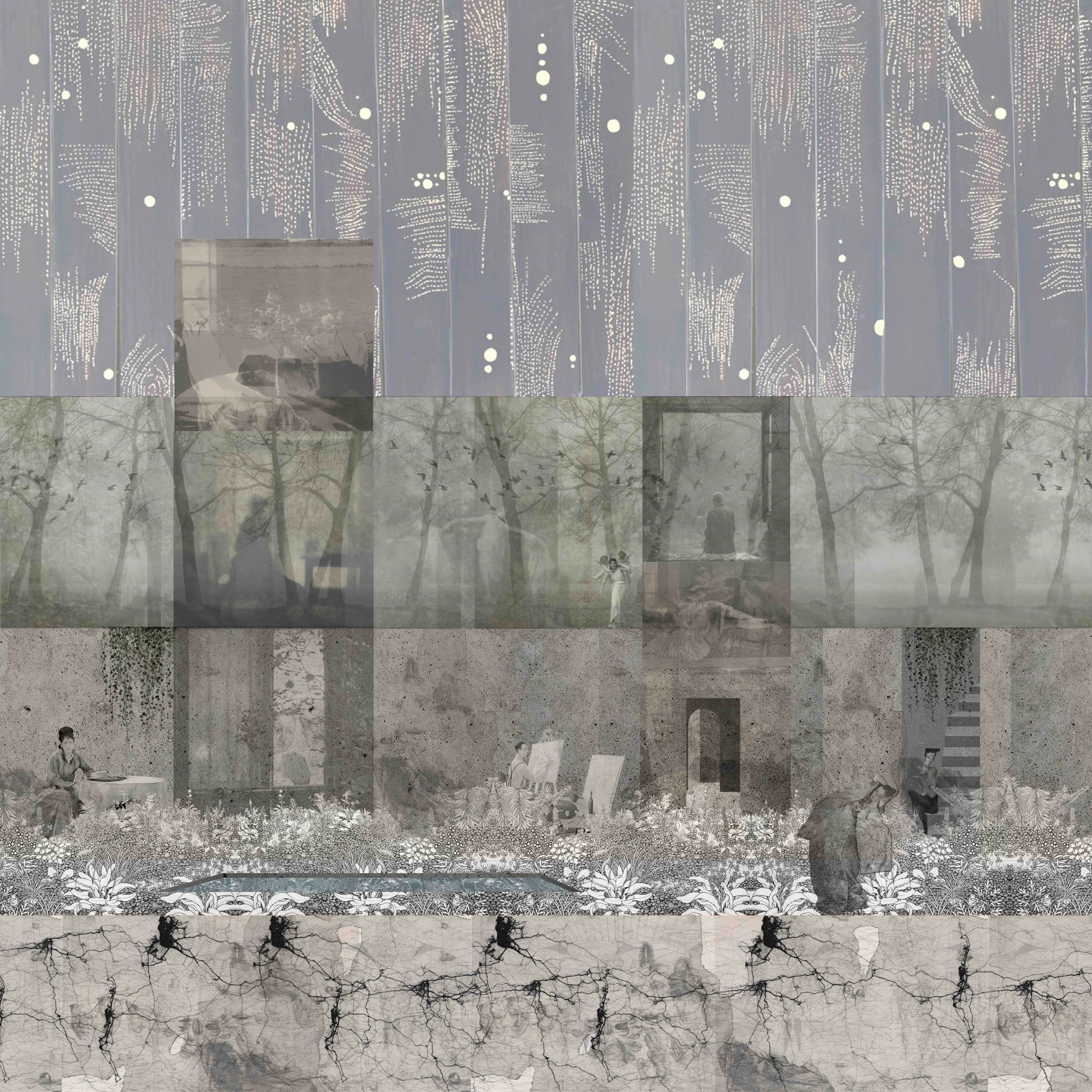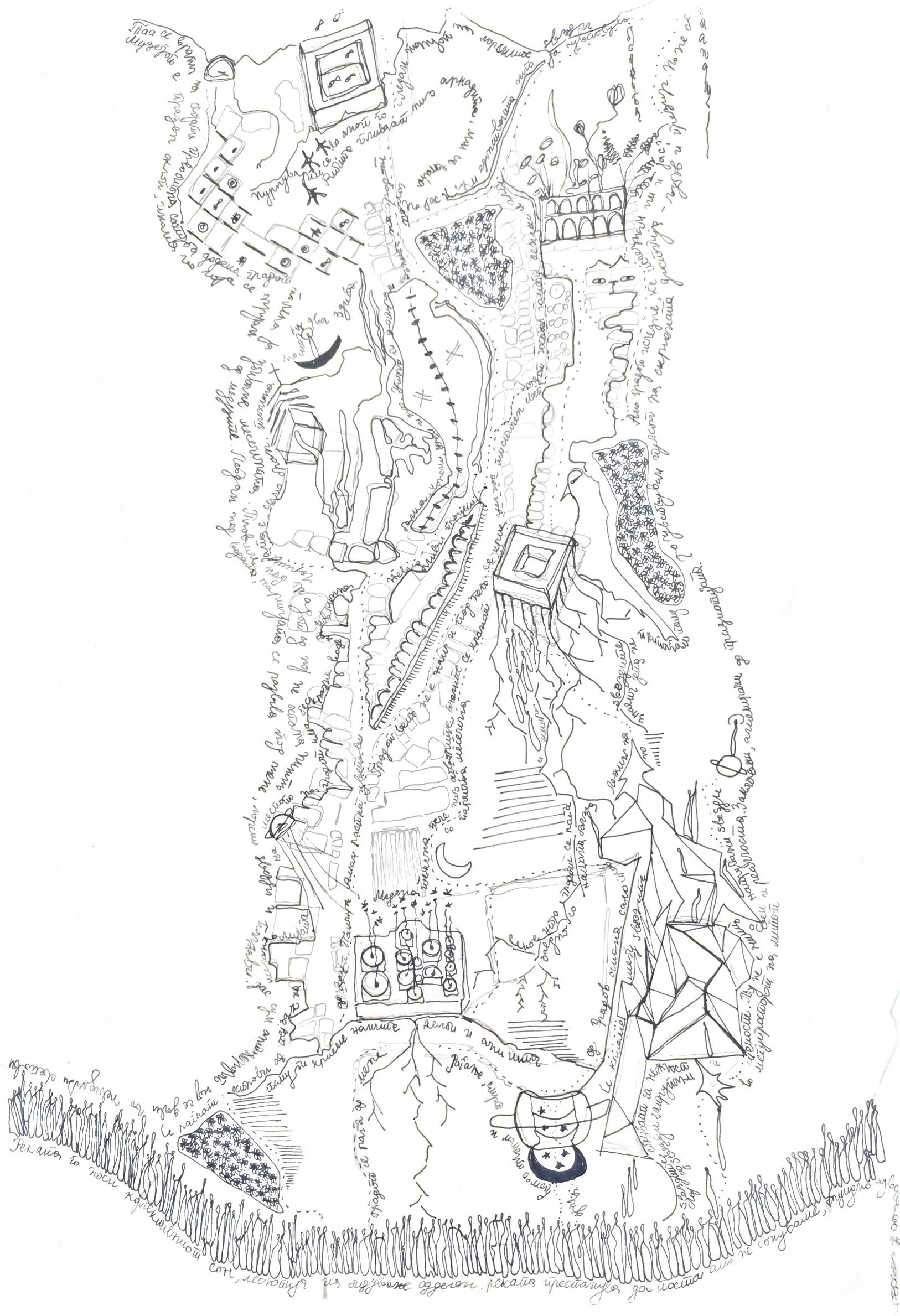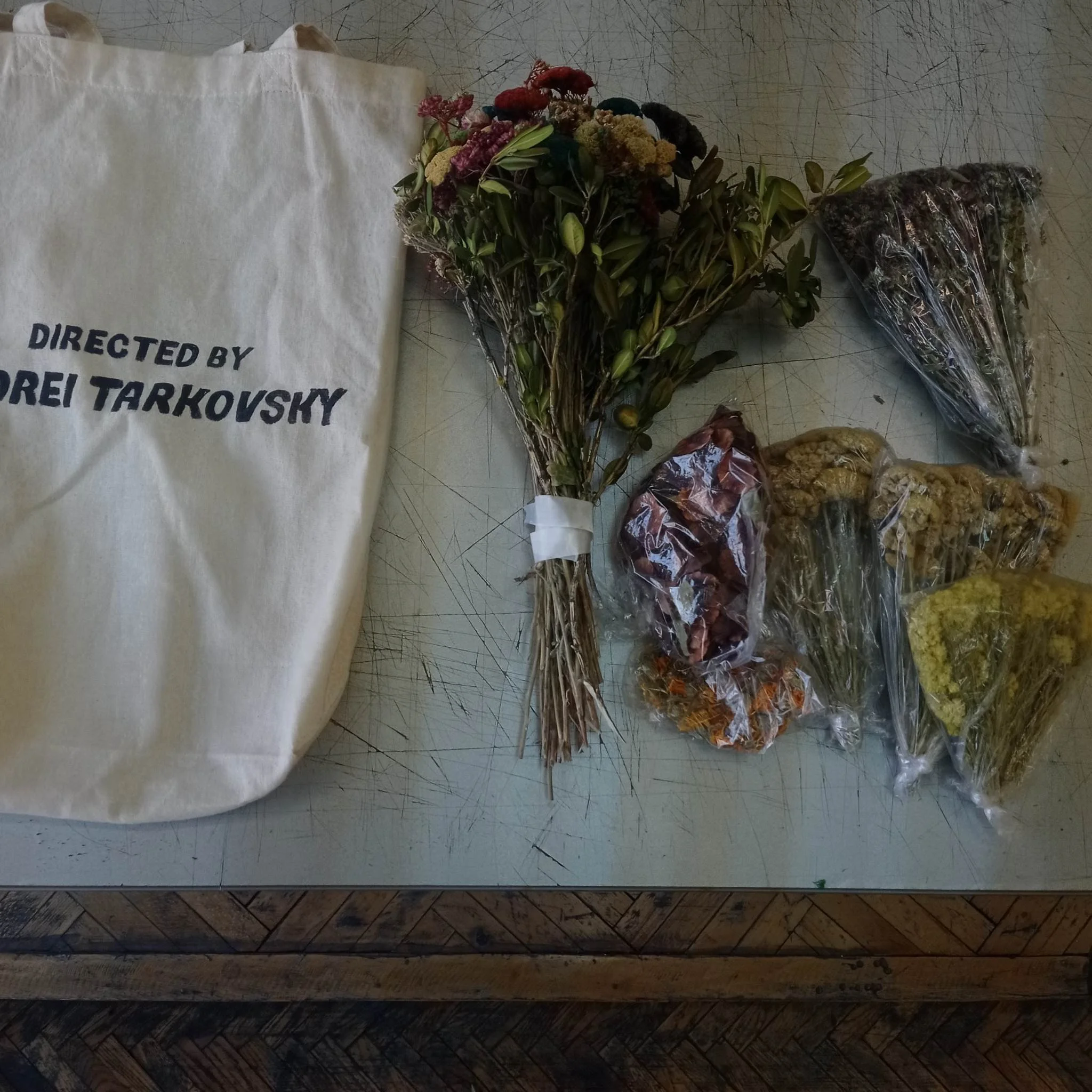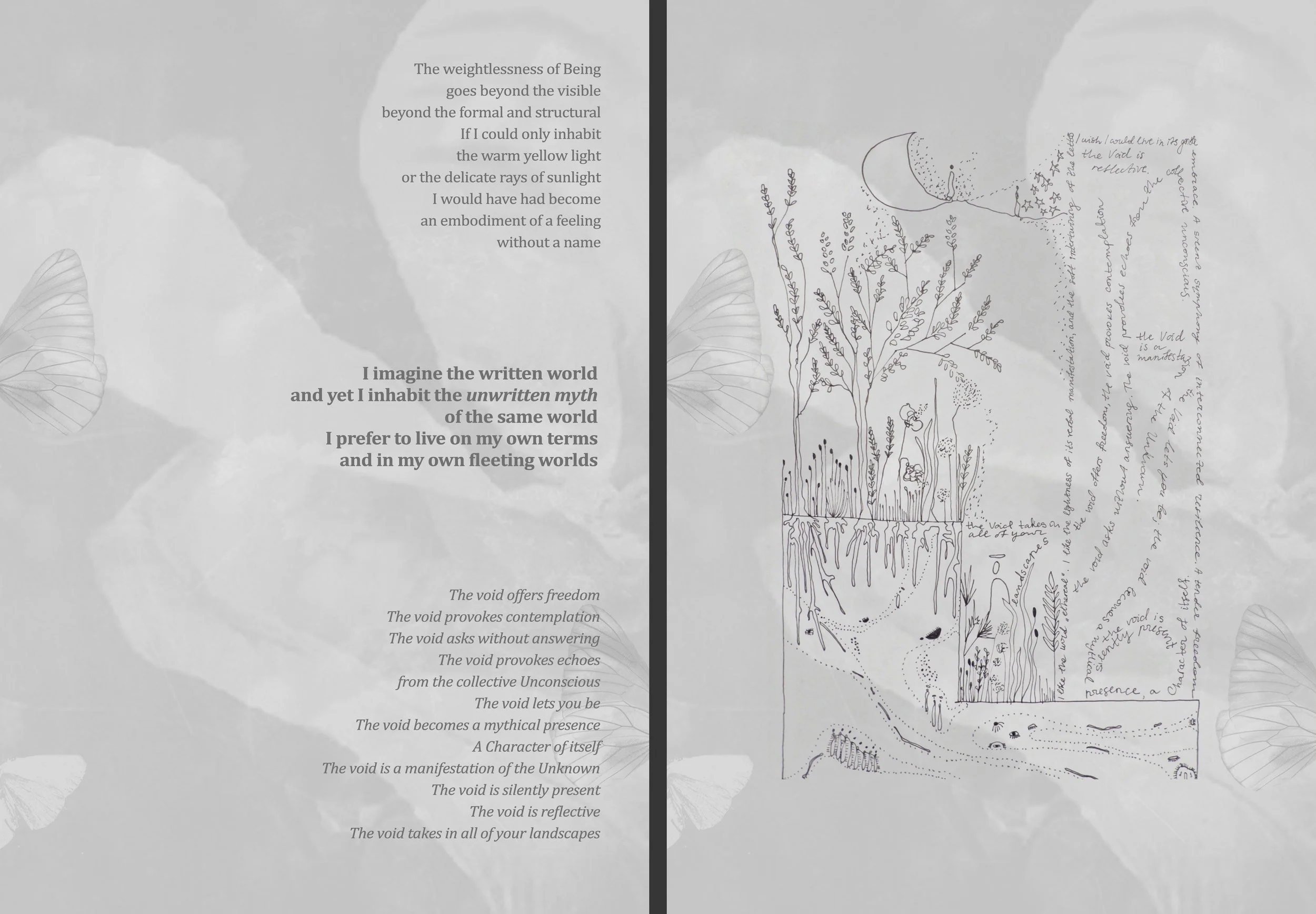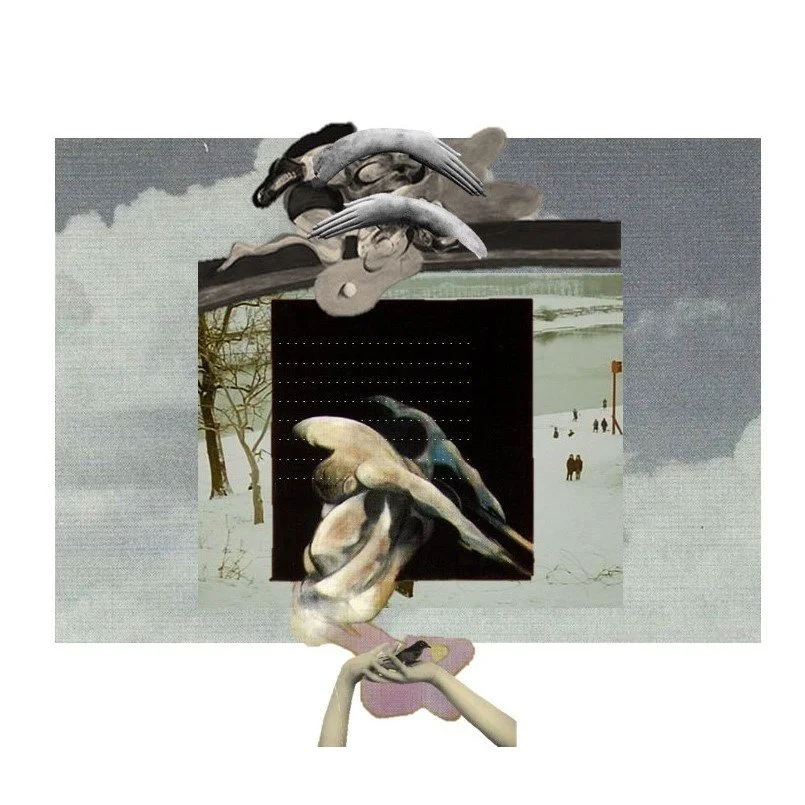Maya Petrevska
Maya, please introduce yourself:
My name is Maya and I'm soon-to-be master of architecture on the Faculty of Architecture in Skopje. In my personal life as well as my architectural work I tend to shift between half-dream states. This is as an attempt to see beyond the rigid state of reality and to get a glimpse into a world that can only be accessed through continuous explorations in the realm of Imagination. I strive to disseminate the idea of using one’s own personal sensitivity as an ultimate act of resistance against the growing alienation of architecture from the sensory intimacy of the spatial experience by using poetic collages, narrative maps, poem-drawings and the written word as tools for challenging pre-existing spatial narratives. My main focus is researching architecture by intimately connecting things that you might not imagine being related.
An Elegy To The Void, © Maya Petrevska
#1 On your Instagram account @sensespat you describe your attitude towards architecture as follows: “softening architecture as a form of resistance”. That sounds very poetic. What is behind this sentence?
I have always felt out of place in my formal education but most importantly I have always felt out of place regarding the definition of architecture that was offered to me by my formal education. I always felt that I was somehow crossing a line when I thought of moving architecture from the point of rigid definiteness and yet I couldn’t force myself into perceiving and creating architecture only from the point of the Rational and the Logical.
A few years ago, while discussing the spatial experience of one of my endless wanderings through Skopje, a colleague of mine said something along the lines that I experience space in such a sensitive manner. He also said that I should use my personal heightened sensitivity and vulnerability as a powerful tool for exploring, imagining and creating architecture in a different, more meaningful way.
So, I soften architecture by surrendering myself and using my own vulnerability. I soften architecture by making it more personal, by creating architecture in accordance with my current inner emotional landscape. In my projects my main focus is the Atmosphere that occurs as an interplay between our memory, our sense of Self and the space – time dialogue. In a way, what I mean by softening architecture is nothing more than creating architecture in accordance with your authentic Self.
#2 In your illustrations you often combine text and drawing. How did that come about and what do you want to convey with it?
It was during my third semester of architecture school that I began to experiment with watercolor sketches and intertwining them with text and I didn’t even know that there was a name for this nor that that this was an actual tool of reflecting on my sensitive spatial explorations. Then I met Viktorija Bogdanova (PhD Arch.), a poet and a practicing architect who is devoted to making, sharing and co-creating poem-drawings as processual and analytical instruments in architectural and urban research through design. The Poem-drawing, according to Bogdanova, is a process of perceiving, reflecting on, and re-creating spatial experience through simultaneously applied modalities of literary and visual expression. It is an instrument for in-depth reading and establishing ties with the place of research, through emotive immersion. While working with Viktorija I finally felt understood, seen, heard and appreciated for my unique way of seeing and perceiving and creating architecure. Viktorija became my (un)official mentor and a dear friend of mine and she plays an important role in the development of my authentic architectural voice. I am beyond grateful for her support, understanding and guidance.
A Map of Mythical Narratives, @ Maya Petrevska
#3 “Mapping” seems to be a tool for you to transport ideas. Can you describe this process to us?
I am relatively new to narrative mapping and yet I am fascinated by this process and I tend to explore it and develop it even further. So, the narrative map is always a translation of a segment of a project that you’re working on. You try to use the mapping process to map the shift from the realm of reality into the realm of floating dreams. So, you use narrative mapping as a tool to map the Atmosphere of a place. The atmosphere has its own language born from the stacked layers of non-linear metaphysical and mythical spatial narratives. It acts as a collector of the collective’s individual dreams, memories, fears, it remembers every footstep and experience, every ray of sunshine, every transformation of the landscape (above and below), every story and every history, it remembers time and it remembers transformations, it remembers its inhabitants (alive or dead, visible or invisible), it remembers the wounds, the pain, the violence and the echoes. And basically what you get as an end result is a complex multi-layered new narrative that is intertwining the intangibility of the Atmosphere, the theoretical base behind the concept of the project, the invisible transformations and the unbuilt Reality (the scenes of everyday life, zones of different spatial uses etc).
#4 Can you tell us a little more about “A Map of Mythical Narratives”?
Dialogues with the Hidden Creatures of the Old Bazaar, @ Maya Petrevska
The maps of mythical narratives are a segment of the collaborative project “Elegy to the Void” between me, Angela Krstevska and Sara Atanasovska made as a part of the integrative studio IX “Growth 2.0 : Settlement”..
The Map of Mythical Narratives is an ethereal example of a radical approach to creating architecture by unveiling the mythical world within the ordinary world. This map is nothing more than an echo of the invisible world that you can only have a glimpse of when you close your eyes. The map represents a segment of our project where the technical reality of the project is translated into a world of soft-spoken narratives of everyday life, intertwining the notion of Home with the notion of extending the Home beyond its walls and into the landscape. This is a method of researching the fragility and softness of architecture and one of the tools is also using poetry, both mine and of already established authors like Elizabeth Brett Jenkins, Eileen Myles and Derek Mahon. On the map I’m enclosing a territory with an embroidery of fragile landscapes that are a translation of the different types of landscapes in our project, thus creating a contemporary mythical labyrinth hidden in plain sight. The map is a reflection of my own need to understand architecture better by seeing beyond the real and into the world where the interconnectedness of architecture and nature is evident, where the myths, dreams and invisible transformations are intertwined with the architecture that I’m creating. Through this mapping process I strive to show how, in order to understand your own work, you have to fully immerse yourself in the world of imaginary narratives in order to understand the reality better.
#5 What does a design process look like for you? What are your most used tools?
I always start by developing the theoretical and conceptual bases behind the project before I proceed to actually start creating the technical reality of the project. I tend to do an interdisciplinary research, making references with other audio, audio-visual and literary forms, using for example the movies of Tarkovsky or Lynch to convey a certain feeling through layering the space with poetic meanings, using the music of Yann Tiersen or Beach House to predict the atmosphere of a certain space, using poetry as a way of deepening the understanding of the space that I’m creating and also using tools that I have learned in the ArchiContemplatives Urban Storytelling Course: Writing and Drawing Practices in Architecture (https://www.archicontemplatives.com). In my design process I always strive towards asking myself the question: How would *this* make the user feel? The thing that really helps me answer this question is the act of practicing sensitive mono-dialogues and trying to feel, feel, feel the space that I’m creating, to let it consume me, dissolve me, disarm me from the Rational, to let it work on my emotions like music, to let it dissolve me to the point of becoming shapeless like water, to the point of losing myself.
model making landscape 1, @ Maya Petrevska
#6 What is particularly important to you in the field of architecture?
One of the most important and fascinating things in architecture is the relation between the Self and Architecture, the relation that rests on the notion of mutuality. For me one of the most meaningful values of architecture is the ability to transform the inner landscapes of the user. But also, vice versa, the user has the ability to transform the meaning of that particular space through its personal experience. So, if we want to be able to experience architecture in a multisensory manner (and I am a great supporter of this approach) we need to develop an inclusive model of mutuality between the Self and the Space that is being experienced.
#7 Now that you have graduated (congratulations!) what are your plans/ next steps?
Well, I still need to start (and finish) working on my master thesis but after that I plan to take a three month break to recover from the constant, five year long, almost self-destructive pressure from architecture school and then If I’m lucky enough I would like to continue my education and proceed to becoming a PhD Arch. In the meantime, I plan to focus on cultivating my own architectural voice through theoretical and conceptual research, working on different research papers and documenting my own sensitive spatial explorations (sense-spat).
The Rebirth of Fragility
little book of floating dreams, @ Maya Petrevska
#8 How do you see the role of the architect in today's society?
Architecture doesn’t need to be rigid and strict, but rather it can be an imagining of a brand new world – a world that might only exist in the Imagination of the author - but that doesn’t make it less real. The architect in today’s society needs to be able to see beyond the rigidity of the real - this presents a shift in architectural thinking and exploration. These mental exercises in Fantasy are crucial for enhancing or developing the Imagination of the Architect – if One can imagine the moon melting in its own Unbuilt Reality, One can surely imagine and believe that its Unbuilt Reality can offer a new way of life to Humans. Architects with a powerful Imagination will believe in the simple, truly possible transformative potential of architecture. Also, the architect in today’s society needs to be more radically kind and to go a step back and strive towards creating something meaningful on a micro-scale that will inspire a change rather than trying to solve everything. We can’t change the world but we can certainly become more loving and kind within the frame of our own profession.
#9 Three things that inspire you at the moment?
1. Spring
2. The person I love
3. The atmospheric language of Tarkovsky
Dream(e)scape
#10 What do you currently read, watch, listen to?
I have been listening to Beach House during the design process of almost every project that I have ever worked on. So, I’m currently mainly listening to Beach House, Porridge Radio and Lana Del Rey’s new album of course.
I recently began to rewatch Twin Peaks because it is my ultimate favorite tv show – I am still fascinated by the specific atmosphere and the feeling that Lynch conveys through the show, I have never felt anything like that.
I’m currently reading Room to Dream by David Lynch (my favorite director) and Kristine Mckenna as well as All About Love: New Visions by Bell Hooks in order to deepen my understanding of the concept of love as a radical force for change because I decided to retreat into the field of radical tenderness and to revolt by loving more. To revolt by making architecture as gentle, fragile and personal as it can be.
In a way I am reclaiming architecture by softening its edges to the point of dissolving, to the point of now knowing where one ends and where the space begins.
Links
Instagram : @sensespat
Photo Credits: © Maya Petrevska , Interview Caroline Steffen

